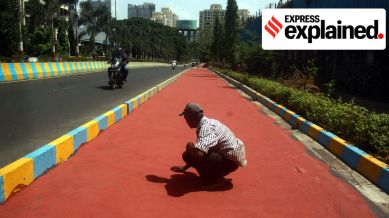Why Mumbai’s cycle tracks failed while global cities pedal ahead
While dedicated cycle tracks thrive in cities globally, including Amsterdam, Beijing and many others, dedicated cycling infrastructure has failed to take off in Mumbai despite substantial investments by urban local bodies.

Cycling tracks are a vital element of sustainable urban transport in many global cities. When planned and implemented effectively, they promote daily commuting by bicycle, ease traffic congestion, and improve air quality. While dedicated cycle tracks thrive in cities globally, including Amsterdam, Beijing and many others, dedicated cycling infrastructure has failed to take off in Mumbai despite substantial investments by urban local bodies.
The Mumbai Metropolitan Region Development Authority (MMRDA), which developed the Bandra-Kurla Complex (BKC) as a major commercial business district, has proposed the construction of dedicated cycling lanes as part of its mobility plan. The goal was to enhance last-mile connectivity and promote environmentally sustainable commuting. However, the agency recently presented a comprehensive plan to decongest the BKC, which includes converting underused cycle tracks into vehicular lanes.
monthly limit of free stories.
with an Express account.
When did Mumbai’s cycling track initiative begin?
The concept of dedicated cycling infrastructure in Mumbai first emerged in 2009. In 2011, a green-coloured cycle track was inaugurated at a cost of Rs 6 crore. However, the project failed to meet its objectives. In the absence of enforcement and traffic discipline, motorcyclists quickly encroached upon the track, and it became used as vehicle parking. Over time, without proper maintenance or public support, the cycling lane fell into disuse.
What were Mumbai’s plans for cycling tracks?
Over the years, several agencies, including the Mumbai Metropolitan Region Development Authority (MMRDA) and the Brihanmumbai Municipal Corporation (BMC), have announced ambitious plans to create a network of dedicated bicycle lanes across the city.
Following 2010, the MMRDA proposed multiple cycling corridors as part of its urban mobility vision. One of its most significant initiatives, the Comprehensive Transportation Study (CTS-2) envisioned over 1,000 kilometres of cycling tracks in Mumbai by 2041. Proposals included dedicated lanes along the Western Express Highway and the under-construction Virar-Alibaug Multi-Modal Corridor. However, none of these projects advanced beyond the planning stage.
The BMC, too, launched its own initiatives, most notably the construction of a dedicated cycling track alongside the Tansa Water Pipeline, stretching from Sion to Mulund. Despite initial implementation, this project fell into neglect and eventual disuse.
Why are cycle tracks failing in Mumbai?
While cycling has gained popularity as a form of exercise both globally and in Mumbai, dedicated bicycle lanes in the city have largely failed to serve their intended purpose. Urban planners and mobility experts attribute this failure to a combination of poor planning, inadequate infrastructure, and lack of public engagement.
Mumbai’s chronic space constraints pose a major challenge. With roads already overcrowded and traffic jams a daily norm, allocating wide, uninterrupted stretches exclusively for cyclists is often seen as impractical and indulgent. In areas like the Bandra-Kurla Complex (BKC), for example, the absence of physical separation between cyclists and motor vehicles has led to frequent conflicts between motorists and pedestrians.
In many cases, the cycling tracks that were built fell short of international design standards. Complaints about uneven surfaces, poor signage, and lack of continuity were common. Even as interest in recreational cycling grew, the supporting ecosystem never materialised. There were no dedicated bike rental services, repair stations, or secure parking, making daily cycling logistically difficult for commuters.
Another major issue was encroachment and lack of enforcement. With little regulatory oversight, many tracks were overtaken by street vendors, parked vehicles, and pedestrian spillover, rendering them unusable.
“It was an idea whose time had not come in the city. We first need to address Mumbai’s core infrastructure challenges before introducing systems that have succeeded in Western cities. Both the public and the planners have yet to treat cycling as a serious, integrated mode of transport. It was a system that was bound to fail,” said a former MMRDA official involved in the city’s first cycling track project.
What is the way forward?
Faced with worsening traffic congestion in the Bandra-Kurla Complex (BKC), the Mumbai Metropolitan Region Development Authority (MMRDA) has decided to dismantle the existing, largely unused Dedicated Cycle Tracks (DCTs) in the area.
The decision, approved during a recent MMRDA meeting, is part of a broader plan to improve traffic flow and reduce peak-hour delays in one of Mumbai’s busiest business districts. Spanning 370 hectares, BKC now sees a daily influx of over 2 lakh employees and 4 lakh visitors. The situation has been further aggravated by the closure of the Sion bridge, which has forced heavy vehicles to pass through BKC’s already narrow internal roads, prompting the authority to fast-track both short- and long-term decongestion measures.
As part of this plan, sections of the current cycling infrastructure will be converted into additional traffic lanes, increasing road capacity by an estimated 600 to 900 vehicles per lane. For example, some existing two-lane (2+2) roads with 2.7-meter-wide cycle tracks will be expanded to three lanes in each direction (3+3). The MMRDA has allocated Rs 25 crore for the conversion, on top of the Rs 6.25 crore previously spent on constructing these DCTs.
Presently, there are no new proposals under consideration for dedicated cycling tracks in the city.